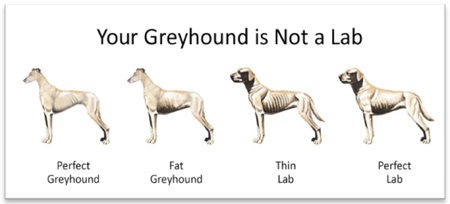We've been trying to find a nice way to tell you, so we held a meeting and decided it was time for an intervention. So here it is: Your Sighthound is fat.
I know this comes as a terrible shock—and it doesn’t mean your Greyhound or Saluki or Borzoi isn’t beautiful and sweet and well-loved. It does, however, mean that your dog has a 50 percent greater chance of developing cancer. Yes, that’s right, cancer. The big C. And if that doesn’t scare you straight (or your dog skinny) your dog is also at risk for other health problems ranging from severe joint pain to heart and kidney issues.
How did this happen, you might ask. Well, quite naturally it seems. You didn’t make your Sighthound fat because you didn’t care—you made it fat because you cared too much. When you picked up your Greyhound from the track or your Galgo from the airport he was very, very thin. It broke your heart and you made it your mission to put weight on him. You’ve succeeded a bit too well.
The problem is your Sighthound is not a lab. Take a look at the picture below.
A fat Greyhound looks just like a thin lab (with an unusually pointy noise and severe narcolepsy). If this was your first Sighthound and you’d only ever seen “normal” dogs before, then the “fresh from the track or shelter” thinness was very alarming. It may have also been alarming to your friends and neighbors who, upon meeting your new dog, repeatedly admonished you to “feed that dog!”
Well, shame on you for giving in to peer pressure! If your Sighthound has gained more than five pounds since he or she came to your home, you need to take a step back—literally, back away from the dog—and take a good look. How many ribs can you see? From across the room you should be able to see the first three. Can you see his hip pins? On some Sighthounds you can even see their vertebrae—gasp!--and that's totally okay. If you have a Borzoi or an Afghan, take a look the next time you're giving them a bath. How much dog--exactly--is there under all of that hair?
When you have come to grips with the emotional trauma of realizing that your Sighthound is, in fact, fat . . . the time has come to un-fattify your dog. (Yes, we’re sure that’s a word.) Keep in mind that it is often a good idea to consult your veterinarian before any diet changes. We’ll have a future post with dieting tips (for your dog, not you) and a discussion of food options.
Until then, happy dieting!

![fat1[1]](https://sighthoundunderground.com/blog/wp-content/uploads/2013/12/fat11.png)
Ha, ha…mine is not fat….however, my husband’s 8 yo Anubis IS pudgy!
I am anal about FAT dogs!
Patti at Greyt Hearts Service Dogs
It’s so much easier to get your sighthound on a diet than yourself on a diet! Just reduce their kibble by 1/4 (or 1/2, depending on the size of your hound) cup each meal and substitute with green beans. I’ve had several porkers who lost weight and never knew they were on a reduced calorie plan.
We have a lurcher that regularly goes on a green-bean diet and she loves it. I am a bit more radical – 1 cup of food and 1 can of green beans 2x a day and she loses weight and feels special because she is getting something the others aren’t…. or you could get a puppy. The puppy will whip those fat dogs back into shape! I am sure my lurcher has toned up because of our puppy.
The green bean diet is great….just make sure you use frozen, not canned green beans. I told a friend about it, didn’t think to specify, and her comment was,” it’s good, but made my dogs drink a lot of water. :x. Too much salt in the canned!
I use canned but the no-salt added kind. That works fine.
Very luckily the breeder of my saluki, our vet and a couple of good friends of mine made me see that she was really fat; she weighs now 21k, but a few months ago she got as fat as weighing 25k! She is been on a low calorie kibble for months and eats three small portions a day but she feels hungry ALL day long! I’m going to try adding some green beans… and keep my fingers cross!
The article was true. One thing I would have changed is the thin lab fat greyhound thing. I realize the message you were getting across, however, although the diagram was true, the lab pictured was fat and at a healthy weight, and the healthy greyhound was thin and at a healthy weight. So maybe rather than “Fat Greyhound” you could say “Overweight Greyhound”, because the ‘fat greyhound’ wasn’t fat, it was just fat for a greyhound. I’m NOT saying that the ‘fat greyhound’ was at a healthy weight, because the fat greyhound pictured IS indeed overweight or maybe even obese. I’m just saying that the healthy lab was fat by scientific definition (it’s fat but is ALSO healthy) and the fat greyhound wasn’t fat by scientific definition (but is STILL overweight for a greyhound).
I’M NOT SAYING ANY OF YOUR FACTS ARE FALSE, I’M JUST SAYING THAT THE FAT GREYHOUND ISN’T FAT, BUT IT IS OVERWEIGHT. THE HEALTHY LAB IS FAT BUT ISN’T OVERWEIGHT. No wrong information, your wording just had a slight error. Great and helpful article though.